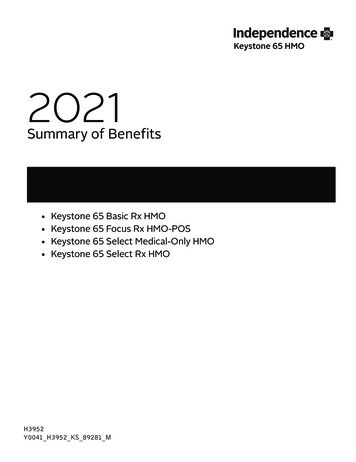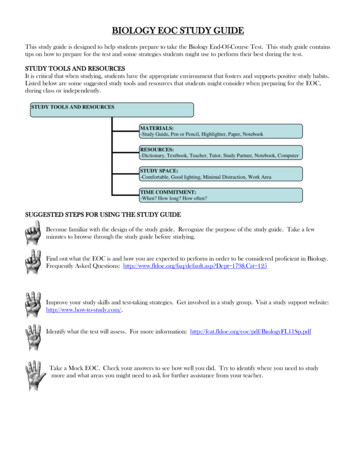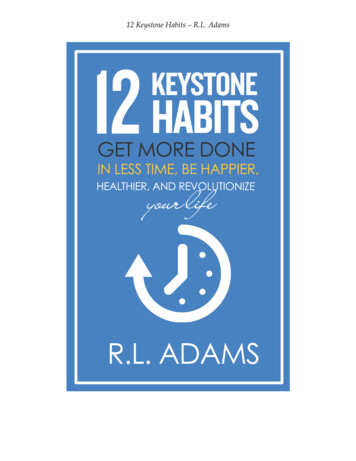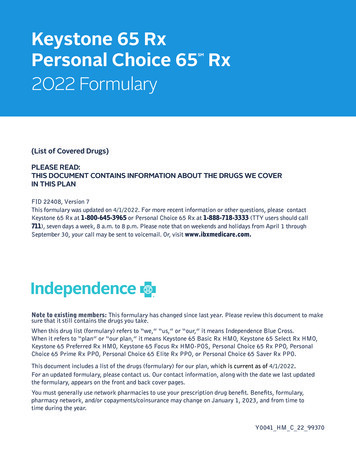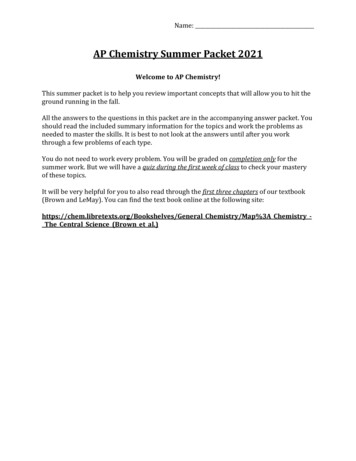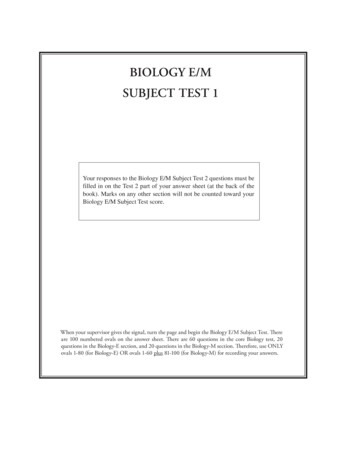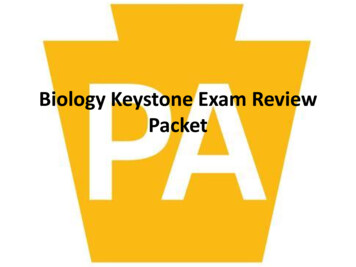
Transcription
Biology Keystone Exam ReviewPacket
1. Which characteristic is shared by allprokaryotes and eukaryotes?A.B.C.D.Ability to store hereditary informationUse of organelles to control cell processesUse of cellular respiration for energy releaseAbility to move in response to environmentalstimuli
All living things: Are made up of cells Have a universal genetic code Need a constant flow of energy Are capable of reproducing (on their own) Grow and Develop Have a level of organization (cells, tissue, organs,organ systems, organism) Respond to Stimuli
2.Living organisms can be classified asprokaryotes or eukaryotes. Which twostructures are common to bothprokaryotic and eukaryotic cells?A.B.C.D.Cell wall and nucleusCell wall and chloroplastC. plasma membrane and nucleusD. plasma membrane and cytoplasm
Prokaryotic vs EukaryoticProkaryote Lack a nucleus and membranebound organelles Have cytoplasm, plasma (cell)membrane, a cell wall, DNA andribosomes Bacteria and ArchaeEukaryotes Have membrane bound organelles Have a true nucleus with a nuclearenvelope Have a plasma membrane,cytoplasm, DNA, ribosomes,endoplasmic reticulum, golgiapparatus, nucleolus w/i thenucleus, vacuoles, a cell wall (insome) and other organelles. Protists, Fungus, Plants, Animals
3. Prokaryotic cells are generally muchsmaller than eukaryotic cells.Part A: Identify a structural differencebetween prokaryotic cells and eukaryoticcells that is directly related to theirdifference in size.
3. Prokaryotic cells are generally muchsmaller than eukaryotic cells.Part B: Based on structural difference,explain why prokaryotic cells can be muchsmaller than eukaryotic cells.
Prokaryotic cells lack membrane-bound organelles. Contain:– Ribosomes– DNADue to the lack of organelles, the total volume of the cell is smaller. Cells with organelles(eukaryotic) have the ability to metabolize materials and retain a larger size.No specialization of function due to a lack of organelles. Enzymes within the cytoplasm carryout the metabolic functions of the cellEukaryotic cells contain membrane-bound organelles and organelles such as:– Mitochondria– Endoplasmic reticulum– Vacuoles– Lysosomes– golgi apparatus– Nucleus with DNA– Nucleolus– RibosomesHave a greater division of labor. Organelles are specialized.Prokaryotic cells and eukaryotic cells both contain ribosomes, cytoplasm, a plasma membrane,and genetic material
3.Prokaryotic cells are generally muchsmaller than eukaryotic cells.Part C: Describe one Similarity betweenprokaryotic cells and eukaryotic cells thatis independent of size.
All cells contain:– genetic information in the form of DNA– ribosomes(cell organelles) that translate nucleicacid (RNA) into protein– a plasma membrane to create an internalenvironment and allows for the movement ofmaterials from one side to another
4. Alveoli are microscopic air sacs in the lungs ofmammals. Which statement best describes howthe structure of the alveoli allows the lungs tofunction properly?A. They increase the amount of energy transferredfrom the lungs to the blood B. They increase the flexibility of the lungs as theyexpand during inhalation.C. They increase the volume of the lungs, allowingmore oxygen to be inhaled.D. They increase the surface area of the lungs,allowing efficient gas exchange.
The Human Respiratory SystemThe alveoli increase surfacearea for gas exchangeThe membranes of the alveoliare 1 cell thick. Oxygen andCarbon dioxide can easily beexchanged through the thinwalls.Typical human has 700 millionalveoli, accounting for anarea of 70 m2 for gasexchangeAlveoli
5. Which statement best describes an effect of the lowdensity of frozen water in a lake?A. When water freezes, it contracts, decreasing thewater level in a lake.B. Water in a lake freezes from the bottom up, killingmost aquatic organisms.C. When water in a lake freezes, it floats, providinginsulation for organisms below.D. Water removes thermal energy from the land arounda lake, causing the lake to freeze.
Properties of Water1.2.3.4.Is a polar covalent moleculeIs the Universal solvent due to itspolarity. Polar covalent compounds(like glucose) and ionic compounds(like salt) can easily go into solution inwater.Has a high specific heat. It is slow toheat up and also slow to cool down.This acts as an insulator in livingorganisms since the majority of theirliving tissue is water.When water freezes, it expands andtherefore floats. Ice is less dense thanwater. This provides an insulation tothe organisms in the water. The waterbelow will be at 4 C (if ice is above it)
6. Which statement correctly describes howcarbon’s ability to from four bonds makesit uniquely suited to form macromolecules?A. It forms short, simple carbon chains.B. It forms large, complex, diverse molecules.C. It forms covalent bonds with other carbonatoms.D. It forms covalent bonds that can exist in a singleplane.
CarbonMethane Atomic number of 6.– 2 electrons in the 1st orbital and 4 remaining in thevalance orbital.– 4 unpaired will form 4 covalent bonds By bonding with other carbons in chains, rings,single, double and triple bonds, carbon, it canmake all sorts of molecules
7.Use the diagram below to answer the question.Chemical ReactionHO – 1 – 2 – 3 – H HO – 4 - HHO – 1 – 2 – 3 – 4 – H H2OThe diagram shows a reaction that forms a polymer from twomonomers.What is this type of reaction ehydration synthesis
This is dehydration synthesis. During this type ofreaction, a water molecule is removed (an –OH fromone simple monomer and an –H from another to form awater molecule. This joins two monomers together toform a polymer. When adding another monomer to thedimer, another water molecule needs to be removed.Monomer called GlucoseDimer called Maltose
8. Carbohydrates and proteins are two types of macromolecules,which functional characteristic of proteins distinguishesthem from carbohydrates?1.2.3.4.Large amount of stored informationAbility to catalyze biochemical reactionsEfficient storage of usable chemical energyTendency to make cell membraneshydrophobic.
EnzymesEnzymes are proteins, which are biological catalysts. They decrease activation energy, allowing achemical reaction to happen in an organism’s body ata suitable temperature and time rate They enter into a reaction at an Active site to form anEnzyme/Substrate complex
9.Proteins are a major part of every living cell and havemany different functions within each cell. Carbohydratesalso perform numerous roles in living things.Part A: Describe the general composition of a protein molecule. A protein is a polymer of amino acids. When amino acids arejoined by dehydration synthesis (a process that removes waterto form a chemical bond), they form peptide bonds. There are three main components of an amino acid, shownbelow.A dipeptide formed by the removal of waterThere are three maincomponents of an amino acid,shown below.
Part B: Describe how the structures of proteins differ from thestructures of carbohydrates. Proteins are made up of the elements C,H,O,and N while carbohydrates only contain C,H,and O (elemental ratio of these three is 1:2:1) Carbohydrates do not contain peptide bondsformed during dehydration synthesis (alsoknown as a condensation reaction)CarbohydrateProtein
Part C: Describe how the functions of proteinsdiffer from the functions of carbohydrates. Carbohydrates are our essential energymolecules to be use almost immediately(simple sugars like glucose) or stored in theliver as glycogen. Proteins are building and regulatorycompounds (such as hormones and enzymes).Muscles and cell membranes contain proteins
10.) Substance A is converted to substance B in a metabolicreaction. Which statement best describes therole of an enzyme during this reaction?A.) It adjusts the pH of the reaction medium.B.) It provides energy to carry out the reactionC.) It dissolves substance A in the reactionmediumD.) It speeds up the reaction without beingconsumed.
Enzymes are organic catalysts which regulatethe rate of a reaction. They allow reactions totake place under conditions that will notdamage a cell. Enzymes are reusable. They do not breakdown under normal conditions.– Regulated by temperature, concentration and pH.
11.) A scientist observes that, when the pH of the environment surrounding anenzyme is changed, the rate the enzyme catalyzes a reaction greatlydecreases. Which statement best describes how a change in pHcan affect an enzyme? Think of an enzyme like a puzzle piece or akey. If extreme heat is added to it, it will burnor melt, changing its shape. The area wherethe enzyme reacts with the substrate is calledthe active site. If the active site is altered, itcan no longer function This change in shape is called denaturing. See graphs on prior page for clarification
12.) Using a microscope, a student observes a small, green organelle in a plant cell.Which energy transformation most likely occurs first within the observedorganelle?A.) ATP to lightB.) light to chemicalC.) heat to electricalD.) chemical to chemical
PhotosynthesisIs the process whereby organisms convert light energyinto chemical bond energy of glucose It occurs in the Chloroplasts of plant cells
13.) Photosynthesis and cellular respiration are two major processes ofcarboncycling in living organisms. Which statement correctly describes onesimilarity between photosynthesis and cellular respiration?A) Both occur in animal and plant cells.B) Both include reactions that transform energy.C) Both convert light energy into chemical energy.D) Both synthesize organic molecules as endproducts.—
Photosynthesis vs Respiration Think of Photosynthesis like baking a cake. The plant takesraw material (CO2 and H20) and uses light energy to makeGlucose (and releases O2 in the process)Respiration is the process whereby organisms break downglucose to provide energy to all life processesBreaks down glucose (sometimes with O2 and others withoutit), transfers energy to a small energy transferring compoundcalled ATP Think of Respiration like burning the cake. Energy is releasedfrom the bonds of glucose to be stored as ATP.All plants (photosynthetic organisms) undergo bothPhotosynthesis (only in the presence of light) andRespiration (all of the time)All living organisms must go through respiration 24/7
14.) A protein in a cell membrane changed its shape to move sodiumand potassium ions against their concentration gradients.Which molecule was most likely used by the protein as anenergy source?A) ATPB) ADPC) CatalaseD) Amylase
ATP – Temporary energy storagemoleculeATP is a readily usable form of chemical energy.By breaking off the 3rd phosphate (ATP adenosine triphosphate), energy is release toallow reactions to happen, such as changingthe shape of a protein
15.) Use the diagrams below to answer the question.Energy inEnergy inPhotosynthesisEnergy outRespirationEnergy out Part A: Complete the chart below bydescribing energy transformations involved ineach process.
ProcessEnergy TransformationsCO2 and H2O are transformed using the energy from sunlightPhotosynthesis to create C6H12O6 and O2. The captured and used energy isstored in the chemical bonds of glucose (C6H12O6)O2 and C6H12O6 are broken down with a small amount ofinvested energy to form CO2 H2O and a large amount of ATPCellularRespiration which is the energy storage molecule of living things
Part B : Describe how energy transformations involved inphotosynthesis are related to energytransformations involved in cellular respiration. They are, in essence, the reverse of each other.The products of photosynthesis become thereactants for cellular respiration, and theopposite is true. Again, one bakes the cake and the other onebreaks it down to release the energy
16.) Carbon dioxide and oxygen are molecules that can move freely across a plasmamembrane. What determines the direction that carbon dioxide and oxygenmolecules move?A) Orientation of cholesterol in the plasmamembrane.B) Concentration gradient across the plasmamembrane.C) Configuration of phospholipids in the plasmamembrane.D) Location of receptors on the surface of theplasma membrane.
Transport through a membrane byDiffusion Diffusion is the movementof molecules from an areaof high concentration tothat of a lowerconcentration If the concentration ofCO2 or O2 is too high onone side of themembrane, then themolecules would notfreely be able to movefrom an area of highconcentration to an areaof low concentration
17.) A sodium-potassium pump within a cell membrane requires energy to movesodium and potassium ions into or out of a cell. The movement of glucoseinto or out of a cell does not require energy. Which statement bestdescribes the movement of these materials across a cell membrane?A) Sodium and potassium ions move by active transport, and glucose movesby osmosis.B) Sodium and potassium ions move by active transport, and glucose movesby facilitated diffusion.Due to the fact that they are highly charged molecules (and “hate” thenonpolar cell membrane and can’t pass through it) and are trying to moveagainst a concentration gradient (from low high), sodium andpotassium ions require a protein and energy to move across the cellmembrane. Glucose is a large enough molecule (and polar), so it needs the‘help’ of a protein to move it along (facilitated diffusion)C) Sodium and potassium ions move by facilitated diffusion, and glucosemoves by osmosis.D) Sodium and potassium ions move by facilitated diffusion, and glucosemoves by active transport.
Types of Transport across a membrane Passive – by diffusion orosmosis (if water)– No energy is needed.– Driven by concentration gradient Facilitated Diffusion –movement across a membranewith the help of carrier proteins.– No energy is needed– Still driven by the concentration Active transport – energy isneeded to go from an area oflow concentration to a moreconcentrated area
18.) Some animals can produce a potassium ion concentration inside their cells thatis twenty times greater than that of their environment. This ion concentrationgradient is maintained by the plasma membrane Part A: Identify the process in the cell membrane thatproduces this difference in concentration.The process is active transport (needs energy). Part B: Explain the process that occurs as the cell producesthe ion concentration gradient.There are specialized proteins in the cell membrane that actlike “pumps with a toll”. These pumps use ATP (small packetsof energy) to power their transport of Na out of a cell, and K into the cell. Because different numbers of sodium ions andpotassium ions are pumped back and forth, it creates anelectrical gradient where one side of the cell is more positivethan the other side
Sodium-Potassium Pump
Part C: Compare the process of potassium ion transport to anothermechanism that moves material across the plasma membrane. Active transport is specific and also usesenergy, which is the key distinction, asopposed to facilitated diffusion which is alsospecific to a molecule (or ion) but does notrequire energy. An example would be glucoseis too big to pass through the cell membraneon its own, but can do so the with help of aspecific protein.
19.) The rough endoplasmic reticulum and Golgi apparatus work together ineukaryotic cells. What is one way that the rough endoplasmic reticulumassists the Golgi apparatus?1. It assembles nucleic acids from monomers.2. It breaks down old damagedmacromolecules.3. It packages new protein molecules intovesicles.4. It determines which protein molecules tosynthesize.
Protein SynthesisProteins are code for by genes onDNA.1. mRNA “reads” the gene andcarries the message to theribosomes either free in thecytoplasm or attached to theendoplasmic reticulum (Rough1endoplasmic reticulum if theyhave ribosomes on them)2. At the ribosomes on the RER,DNA’s message gets uncodedand Proteins are produced (withthe help of tRNA transferingamino acids (the building unitsof proteins) to the ribosomes3. The proteins produced will betransport to the Golgi apparatuswhich will package the proteinsand4. export proteins to the cell orother cells.243
20.) Which example is an activity that a fish mostlikely uses to maintain homeostasis within its body?A.) Using camouflage to avoid predators.B.) Feeding at night to regulate body temperature.C.) Moving to deeper water to regulate metabolicwastesD.) Exchanging gases through its gills to regulateoxygen levels.O2 is needed for cellular respiration to provideenergy for the organism. At the gills, O2 and CO2 areexchanged. If CO2 is present, the amount of O2 willchange to stay regulated.
21.) Use the illustration below to answer the question.Cell DivisionWhich statement best describes the phase of the cell cycle shown?This diagram is showing the formation of two cellsA. The cell is in prophase of mitosis because the number of chromosomes has doubled.B. The cell is in prophase I of meiosis because the number if chromosomes hasdoubled.C. The cell is in telophase of mitosis because the cell is separating and contains two copiesof each chromosome.D. The cell is in telophase of meiosis because the cell is separating and contains two copiesof each chromosome.At the end of meiosis, you would see 4 genetically different cells with only one copyof each chromosome (here you see 2 cells, and each has 2 matching “sticks” in it)
Cell Division (Mitosis)Cell division results in twoidentical daughter cells.The process of cell divisionsoccurs in three parts: Interphase - duplication ofchromosomes andpreparing the nucleus fordivision Mitosis – organized divisionof the nucleus into twoidentical nuclei Cytokinesis- division of thecell and cellular contentsinto two identical daughtercells Animation
22.) Mitosis and meiosis are processes by which animal andplant cells divide. Which statement best describes a differencebetween mitosis and meiosis?A.B.C.D.Meiosis is a multi-step process.Both processes have multiple steps (prophase, metaphase,anaphase, and telophase, but meiosis has two sets of thesestages with slight differences than the mitosis versions)Mitosis occurs only in eukaryotic cells.Mitosis occurs in prokaryotic and eukaryotic cellsMeiosis is used in the repair of an organism.Mitosis is the process used to repair an organism by creatingmore of the same type of cell (for example, to heal a cut on theleg)Mitosis produces genetically identical daughter cells.Meiosis produces genetically different cells as a result ofcrossing over and chromosome shuffling
Meiosis Meiosis occurs during theformation of sex cells (spermand egg). It is necessary sothat the sex cells only havehalf the number ofchromosomes (23 in us) sothat at fertilization, the normalchromosome number isreturned (46 in us) Meiosis involves two divisions.It begins with the replicationof the chromosomes, dividesup the cell into two cells, thendivides again (withoutreplication) into 4 geneticallydifferent sex cells with half thenormal number ofchromosomes
23.) Patau syndrome can be a lethal genetic disorder in mammals, resultingfrom chromosomes failing to separate during meiosis. Part A: Identify the step during the process of meiosiswhen chromosomes would most likely fail to separate. Most likely chromosomes would fair to separate duringanaphase I or Anaphase II. In anaphase, chromosomes(anaphase I) or sister chromatids (anaphase II) aresupposed to separate, or move AWAY from each other. Thisis called Nondisjunction. Part B: Describe how chromosome separation in meiosis isdifferent from chromosome separation in mitosis. During meiosis cells and the genetic material is dividedtwice (the first set of division is meiosis I and the second setis meiosis II). In mitosis, the cell and chromosomes divideonce.
Nondisjunction and Patau’s syndromeNondisjunctionKaryotype of a normal maleKaryotype of a Patau’s male (noticechromosome #13 has threechromosomes instead of two
Part C: Compare the effects of a disorder caused by chromosomes failing toseparate during meiosis, such as Patau syndrome, to the effects ofchromosomes failing to separate during mitosis. Due to the improper number ofchromosomes, the organism has animproper amount of genetic material inthe form of DNA of the sperm or egg.This mutation will be found in every cellof the organism’s body. If chromosomes fail to separate duringmitosis, it does not affect the sex cellsbut a body cell. This mutant body cellthen can be reproduced and producemore of the abnormal cells. The celleither dies or is replicated quickly. Thiscould possibly lead to cancer if the cellsare not destroyed by the immunesystem.
24.) Which process helps to preserve the genetic informationstored in DNA during DNA replication?A.) The replacement of nitrogen base thyminewith uracil.B.) Enzymes quickly linking nitrogen bases withhydrogen bonds.C.) The synthesis of unique sugar and phosphatemolecules for each nucleotide.D.) Nucleotides lining up along the templatestrand according to base pairing rules.
DNA Replication This is key for DNAreplication. DNA (a doublestranded molecule) splitsinto two halves, and eachhalf serves as a “template”or pattern to build the newhalf. The result is two identicalstrands of DNA– Adenine always pairs withThymine (straight lineletters AT go together) andGuanine always pairs withCytosine (curvy letters GCgo together)
25.) In a flowering plant species, red flower color is dominantover white flower color. What is the genotype of anyred-flowering plant resulting from this species?A. Red and white alleles present on onechromosome.B. Red and white alleles present on twochromosomes.C. A red allele present on both homologouschromosomesD. A red allele present on at least one of twohomologous chromosomes.
Genetics Dominant traits are represented by capital letters,while recessive (non-dominant traits) are representedby lower case letters.– Each parent has two copies of the gene, so they will gettwo letters. The different letters represent the differentalleles (flower pedal color) of a trait.– Since white is the recessive trait, in order to have whitepetals, the flower has to be ff or pure for the white trait.– Since red color is dominant, the red parent could be Ff orFF since it shows red petals. It is either pure for the redtrait or a hybrid for red. When the dominant trait shows, only one allele (formof the gene) must be present to show the trait.
Biology Keystone Exam Review Packet. 1. Which characteristic is shared by all prokaryotes and eukaryotes? A. Ability to store hereditary information B. Use of organelles to control cell process
